Content for TS 28.535 Word version: 17.5.0
4 Concepts and background
4.2 Management control loops
4.2.1 Overview
4.2.2 Control loops
4.2.3 Open control loops
4.2.4 Closed control loops
4.2.5 Closed control loop governance and monitoring
4.2.6 Coordination between closed control loops
4.3 Communication service assurance service
...
...
4 Concepts and background p. 7
4.1 Void
4.2 Management control loops p. 7
4.2.1 Overview p. 7
For communication service assurance one can identify two interactions of management control loops:
- Between the CSC and the CSP: In this case, the CSC provides the requirements for an assured communication service to the CSP, the CSP provides the corresponding communication service, the CSP also provides feedback to the CSC. The CSP adjusts the resources used by a communication service or the CSC adjusts the SLS continuously to achieve the assured requirements.
- Between the CSP and the NSP: the communication service provided by CSP requires the network capabilities. For example, the CSP requires a certain network latency. The NSP management system adjusts the network or CSP adjusts the latency requirement continuously to satisfy the latency requirement.
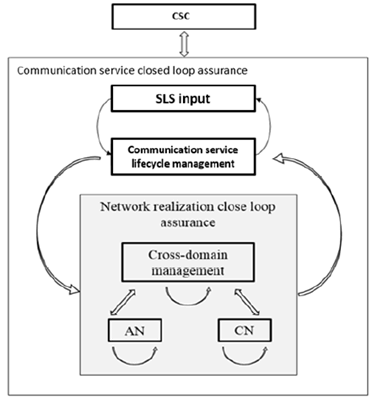
Figure 4.2.1-1 gives a high level description of interaction process involved in the management closed control loop.
Generally, the management control loop for CSA consists of the steps Monitoring, Analysis, Decision and Execution. The adjustment of the resources used for the communication service is completed by the continuous iteration of the steps in a management control loop. As described in clause 4.1, the management closed control loop for the resources used for the communication service is deployed in the preparation phase and takes effect during the preparation phase and operation phase.
Figure 4.2.1-2 shows the overall process of communication service assurance using a management control loop.

4.2.2 Control loops p. 8
A control loop is a building block for management of networks and services. The basic principle of any control loop is to adjust the value of a measured or observed variable (expressed as for example an attribute) to equal the value of a desired goal (expressed as for example an attribute). The producer of the measurements or observations, the control service, and the controlled entity are all required to create a control loop.
For the control loop to act on input in the context of the set goal, the control loop provided through following four steps that continuously consume and produce information from each other in a loop in the following sequence monitor, analyse, decide and execute.
A control loop can be an open control loop in which case a human operator or other management entity intervenes inside the loop A control loop can be closed and operates without human operator or other management entity involvement inside the loop other than possibly the initial configuration of the measurement producer and configuration of control loop.
4.2.3 Open control loops p. 9
In an open control loop, the human operator intervenes in one or more of the process steps inside the loop, see Figure 4.2.3-1. The human operator is in control of the steps in the control loop, including decisions taken in the loop. The management system collects, analyses and presents the data to the operator, but the operator decides which action to take. In this case, the completion time for control loop is dependent on availability and reaction time of a human operator or other management entity.
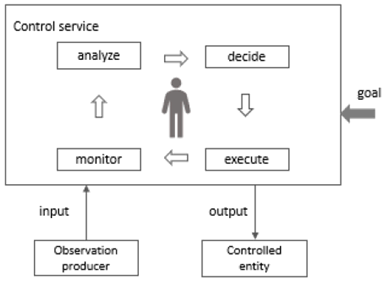
4.2.4 Closed control loops p. 9
4.2.4.1 Description p. 9
In a closed control loop, there is no direct involvement of a human operator or other management entity in the control loop, the control loop is fully automated. As shown in Figure 4.2.4.1-1 the human operator or management entity is not directly controlling the details inside the process steps but provides control outside the loop. For example, configuring goals for the control loop to make autonomous decisions within the boundaries of the set goal. Once the control loop is configured with the goal, the controlled entity is adjusted according to the set goals.
In a closed control loop the input to the control loop provided by human operator or other management entity may include the goal or policies. The output of the closed control loop may include closed control loop status to a human operator or other management entity.
Typically, the goal is set within certain parameter boundaries, the closed control loop can automatically adjust the output based on the input within the parameter boundaries. Once a control loop cannot automatically adjust, the human operator or other management entity needs to be informed. The human operator or other management entity may decide to change the management of closed control loop so that it becomes an open control loop, where decisions are made by the human operator or other management entity and not by the closed control loop.
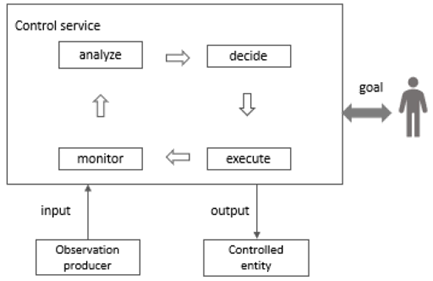
4.2.4.2 Lifecycle phases p. 10
Communication service assurance is enabled by closed control loops which have their own lifecycle. The lifecycle phases for closed control loops are preparation, commissioning, operation and decommissioning.
- Preparation phase: Providing a closed control loop starts with preparation, which includes control loop design, collection of relevant goal information from an SLS and preparing the required network configuration for measurement collection. The result of the preparation phase is a closed control loop design.
- Commissioning phase: Once a closed control loop is prepared, one instance of the closed control loop design is instantiated by configuring the measurement collection and the goals in the network. During this phase the closed control loop may be deployed to allow the network to converge to a state where the communication service assurance is stable and within the boundaries of the SLS. The instantiation activity results in a closed control loop that is ready for operation.
- Operation phase: After the commissioning phase, the closed control loop is operational. The activation includes actions that make a closed control loop run to pursuit its goal(s). It may include subscription to relevant management services. In the operation phase the closed control loop is first activated. The monitor activity typically includes the real-time or periodic calculation of KPIs that are relevant to the closed control loop and comparison with the goal(s) assigned to the given closed control loop. This activity may result in further actions that involve the other activities in the operation phase, e.g. evaluate and update & upgrade, in order to change the closed control loop settings and improve its performance. The evaluate activity also includes the evaluation of results of Execution step of closed control loops by e.g. investigating differences between the current traffic data and the data taken before the execution. The criteria of this evaluation can be done by specific values such as SLS. The update & upgrade activity includes actions that change the settings of the closed control loop instance to change its behaviour and improve its performance to pursue the assigned goal(s). The update may include changes in the parameters of the management functions that constitute the closed control loop (e.g. changing data sources, KPIs being calculated, models, policies, etc.). The upgrade may include changes in the software version of the management functions. These activities can be executed dynamically while the closed control loop is regularly operating and executing actions, or they can be executed upon a request received from an authorized consumer. The deactivation activity includes actions that make the closed control loop stop to run.
- Decommissioning phase: When the closed control loop is no longer needed, after being deactivated the closed control loop is decommissioned and after that the lifecycle of the closed control loop is completed.

4.2.5 Closed control loop governance and monitoring |R17| p. 11
4.2.5.1 Overview p. 11
The closed control loop can be viewed as an entity to be managed, which means the implementation of the internal capabilities and internal interactions between the steps could not be externally visible. However, some management capabilities (e.g. closed control loop governance and closed control loop monitoring) will exposed by the MnS producer, implementing the closed control loops, to enable the MnS consumer to manage the closed control loops.
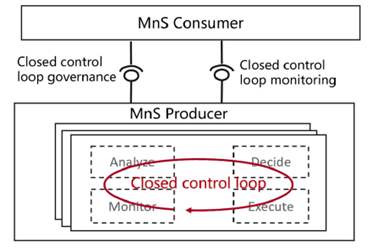
4.2.5.2 Closed control loop governance p. 11
Closed control loop governance describes a set of capabilities to allow MnS consumer to govern closed control loop, including:
- Lifecycle management of closed control loop, including create, modify,activate/deactivate,delete closed control loop.
- Configure goals for closed control loop.
4.2.5.3 Closed control loop monitoring p. 12
Closed control loop monitoring describes a set of capabilities to allow MnS consumer to monitoring the progress and result of closed control loop, including:
- Monitor the goal fulfillment of the closed control loop.
4.2.6 Coordination between closed control loops |R17| p. 12
Different closed control loops reside in the management domains or in the network functions to support automation and the autonomous networks. Different domains may involve overlapping or nonoverlapping coverage areas. The purposes and results of a closed control loop may have impact on other closed control loops. Coordination between closed control loops is needed for example in and between, the Cross Management Domain and 5GC management domain or the NG-RAN management domain, to improve the performance in order to achieve the goal(s) of the closed control loops. Furthermore, coordination may also be needed when conflicts happen between closed control loops related to their activities.
A closed control loop may coordinate with other closed control loops in the same domain or in a different domain. Closed control loops in domain management for 5GC and NG-RAN are responsible for local optimization. Closed control loops in cross management domain may need to coordinate with closed control loops in multiple other management domains for the end to end optimization.
The relationships between closed control loops can be hierarchical and/or peer-to-peer. Coordination in the management domains include the following categories:
- Coordination between Cross Management Domain and the 5GC Management Domain
- Coordination between Cross Management Domain and the NG-RAN Management Domain
- Coordination within Cross Management Domain, 5GC Management Domain or NG-RAN Management Domain
- Coordination within:
- Cross Management Domain,
- 5GC Management Domain and
- NG-RAN Management Domain
4.3 Communication service assurance service p. 12
Communication service assurance relies on a set of management services that together provide the CSP with the capability to assure the communication service as per agreement (for example an SLS) with a CSC (e.g. enterprise). The overall solution and information flows between management services and the closed control loop steps [5] are shown in Figure 4.3-1.
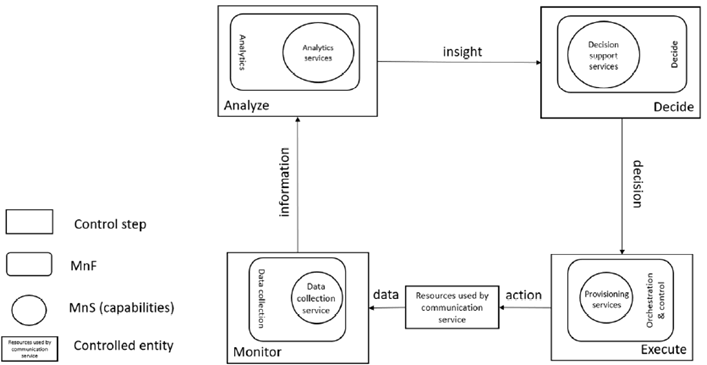
In Figure 4.3-1 the controlled entity represents the resources used by a communication service and the assurance of this communication service is provided by the closed control loop between the different management services provided by the management system.
The input to the closed control loop is the data concerning the resources used by the communication service and corrresponding service KPIs which is monitored by the closed control loop and step "Monitor", analyzed by the closed control loop step "Analyze", a decision on potential solution by the closed control loop step "Decide" which may be a possible action for the closed control loop step "Execute", The role of the decision support services is to provide variable degrees of automated decision making and human oversight support. The following two examples demonstrate how a closed control loop can be used:
- when a service experience degradation is detected (for example due to resource shortage or faults in the network), the resources used by a communication service may be adjusted automatically to improve the service experience
- the data associated with the communication service is monitored by the management services for data collection, this management service provides information to an assurance root cause analysis management service (example of an analytics service) and based on that information the assurance root cause analysis takes place, followed by proposing activities, mitigation or suggestions to solve the problem. The proposed activities, for example mitigation or problem-solving suggestion(s) are executed through provisioning services to bring the behaviour of the communication service within the requested boundaries of the metrics (SLS goals) that are controlled by the closed control loop.